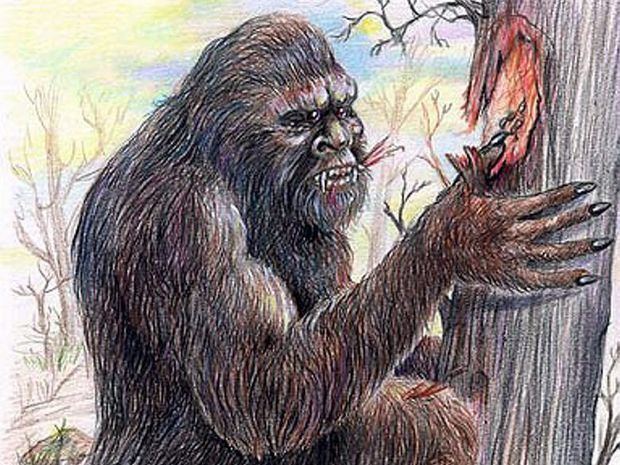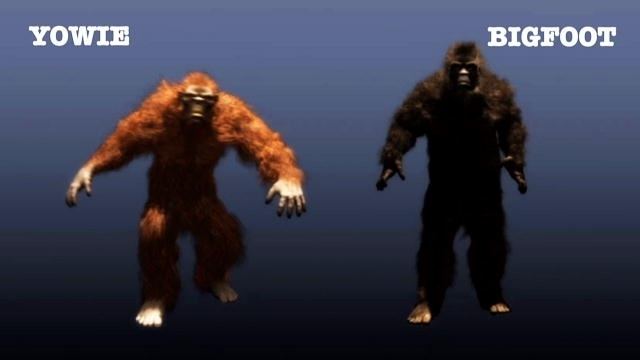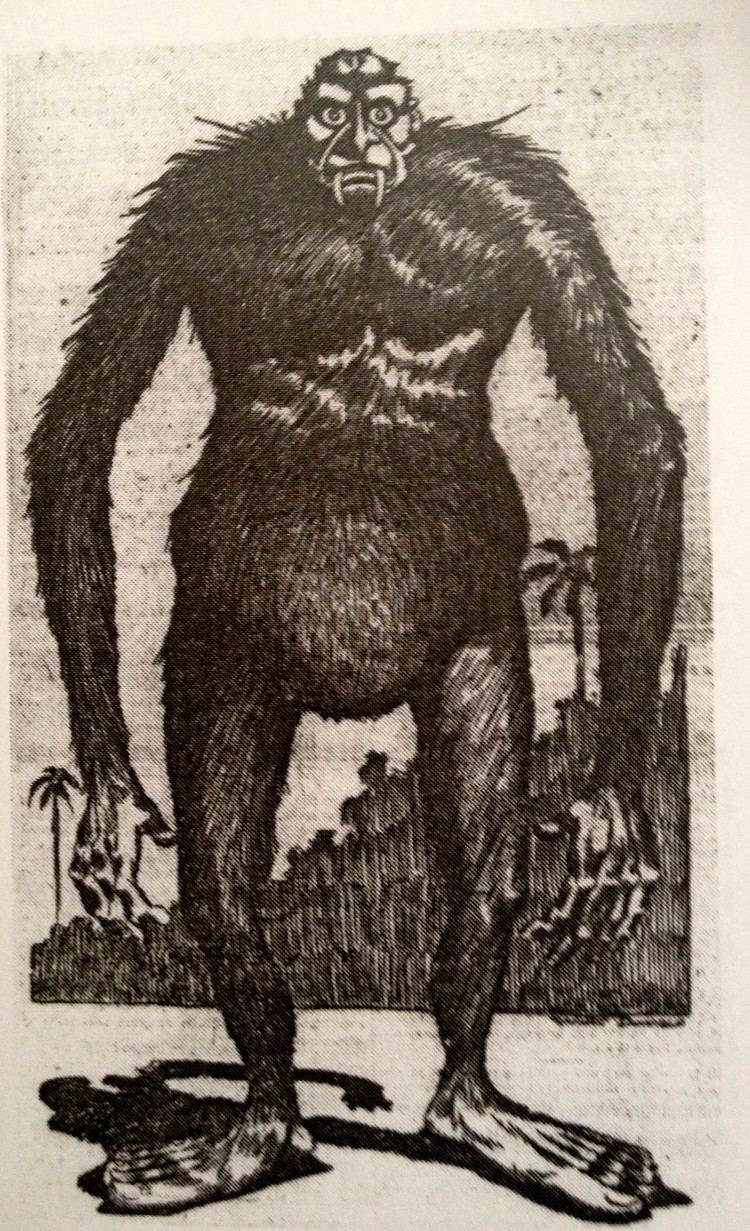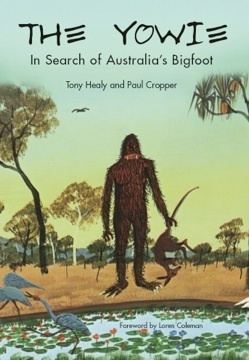Country Australia | ||
 | ||
Region Great Dividing RangeNorthern TerritoryAustralian Capital TerritorySouth AustraliaWest AustraliaNew South WalesQueensland Similar Bunyip, Yara ma yha who, Orang Pendek | ||
Yowie is one of several names given to a hominid reputed to live in the Australian wilderness. The creature has its roots in Aboriginal oral history. In parts of Queensland, they are known as quinkin (or as a type of quinkin), and as joogabinna, in parts of New South Wales they are called jurrawarra, myngawin, puttikan, gubba, doolaga, gulaga and thoolagal. Other names include yahoo, yaroma, noocoonah, wawee, pangkarlangu, jimbra and tjangara.
Contents
- Yowie jumps between two trees on top of the mountain
- Description
- Origins of the term
- History of sightings
- 19th century eyewitness accounts
- Present day accounts of yowie sightings
- Australian Capital Territory
- New South Wales
- Northern Territory
- Queensland
- Prominent yowie hunters
- References

Many people discount the existence of the yowie considering it more likely to be a combination of misidentification, folklore and hoax. Yowie-type creatures are common in Aboriginal Australian legends, particularly in the eastern Australian states.

Yowie jumps between two trees on top of the mountain
Description

The yowie is usually said to be a hairy and ape-like creature standing upright at between 2.1 m (6 ft 11 in) and 3.6 m (12 ft). The yowie's feet are said to be much larger than a human's, but alleged yowie tracks are inconsistent in shape and toe number, and the descriptions of yowie foot and footprints provided by yowie witnesses are even more varied than those of bigfoot. The yowie's nose is said to be wide and flat.

Behaviourally, some report the yowie can seem timid or shy. Others suspect that the yowie is sometimes violent or aggressive.
Origins of the term

The origin of the name "yowie" to describe unidentified Australian hominids is unclear. Some nineteenth century writers suggested that it arose through Aboriginal legends. Robert Holden recounts several stories that support this from the nineteenth century, including this European account from 1842:
Another story about the name, collected from an Aboriginal source, suggests that the creature is a part of the Dreamtime.
On the other hand, Jonathan Swift's yahoos from Gulliver's Travels, and European traditions of hairy wild men, are also cited as a possible source.
History of sightings
In a column in the Sydney Morning Herald in 1987, columnist Margaret Jones wrote that the first Australian yowie sighting was said to have taken place as early as 1795.
19th century eyewitness accounts
In the 1870s, accounts of 'Indigenous Apes' appeared in the Australian Town and Country Journal. The earliest account in November 1876 asked readers; "Who has not heard, from the earliest settlement of the colony, the blacks speaking of some unearthly animal or inhuman creature ... namely the Yahoo-Devil Devil, or hairy man of the wood ..."
In an article entitled "Australian Apes" appearing six years later, amateur naturalist Henry James McCooey claimed to have seen an "indigenous ape" on the south coast of New South Wales, between Batemans Bay and Ulladulla:
McCooey offered to capture an ape for the Australian Museum for £40. According to Robert Holden, a second outbreak of reported ape sightings appeared in 1912. The yowie appeared in Donald Friend's Hillendiana, a collection of writings about the goldfields near Hill End in New South Wales. Friend refers to the yowie as a species of bunyip. Holden also cites the appearance of the yowie in a number of Australian tall stories in the late nineteenth and early twentieth century.
Present-day accounts of yowie sightings
Yowie reports have continued to the present day with the trail of evidence following the pattern familiar to most unidentified hominids around the world: eyewitness accounts; mysterious footprints of hotly disputed origin; and no conclusive proof. Some recently reported yowie incidents claim that the death and mutilation of household pets, such as dogs, are the result of yowie attacks. Other people claim that the animals' deaths can be attributed to attacks by wild animals such as dingoes.
Australian Capital Territory
In 2010, a Canberra man spotted a creature that may have been a yowie in his garage. The man reported the creature as being covered in hair, juvenile with long arms. He said it was definitely trying to communicate with him.
New South Wales
There have been hundreds of accounts of yowie-sightings in New South Wales, including:
In the mid-1970s, the Queanbeyan Festival Board and 2CA together offered a AUD200,000 reward to anyone who could capture and present a yowie: the reward is yet to be claimed.
Northern Territory
In the late 1990s, there were several reports of yowie sightings in the area around Acacia Hills. One such sighting was by mango farmer Katrina Tucker who reported in 1997 being just metres away from a hairy humanoid creature on her property. Photographs of the footprint were collected at the time.
Queensland
The Springbrook region in south-east Queensland has had more yowie reports than anywhere else in Australia. In 1977, former Queensland Senator Bill O'Chee reported to the Gold Coast Bulletin he had seen a yowie while on a school trip in Springbrook. O'Chee compared the creature he saw to the character Chewbacca from Star Wars, telling reporters that the creature he saw had been over 3 metres tall.
A persisting story is that of the Mulgowie Yowie, last reported to be seen in 2001.
In March 2014, two yowie searchers claimed to have filmed the yowie in South Queensland using an infrared tree camera, collected fur samples, and found large footprints. Later that year, a Gympie man told media he had encountered yowies on several occasions, including conversing with, and teaching some English to, a very large male yowie in the bush north east of Gympie, and several people in Port Douglas claimed to have seen yowies, near Mowbray and at the Rocky Point range.
